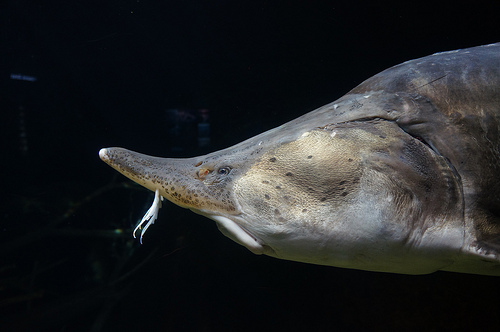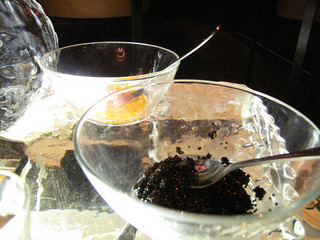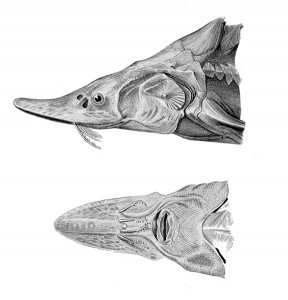 Even the dead kept watch. They sat upright in their graves, men and women, and faced the river, waiting, it seemed, for the waters to roil again with massive, steel-grey fish. The sturgeon, barbeled giants with rows of bony scutes down their backs, appeared each spring in Serbia’s Danube Gorge, after battling the current all the way from the Black Sea. The largest of these fish weighed more than a dozen men. The oldest of these Beluga sturgeon survived more than a century.
Even the dead kept watch. They sat upright in their graves, men and women, and faced the river, waiting, it seemed, for the waters to roil again with massive, steel-grey fish. The sturgeon, barbeled giants with rows of bony scutes down their backs, appeared each spring in Serbia’s Danube Gorge, after battling the current all the way from the Black Sea. The largest of these fish weighed more than a dozen men. The oldest of these Beluga sturgeon survived more than a century.
 Beluga caviar may well be the world’s most expensive foodstuff. Demand has long far outstripped supply, and the palest roe, which apparently possess a subtle, buttery flavor, now sell for $10,000 per pound. But a black market in Beluga caviar has long prospered and poachers are unable to resist the call. Wild sturgeon are on their way out: they currently hover at the “critically endangered” mark.
Beluga caviar may well be the world’s most expensive foodstuff. Demand has long far outstripped supply, and the palest roe, which apparently possess a subtle, buttery flavor, now sell for $10,000 per pound. But a black market in Beluga caviar has long prospered and poachers are unable to resist the call. Wild sturgeon are on their way out: they currently hover at the “critically endangered” mark.
I had no idea that these huge fish once ran in the Danube River, much as salmon now run in the river below my house, until I came across a recent paper by a Serbian archaeologist, Ivana Zivaljevic. Zivaljevic is writing a Ph.D. dissertation on the role that fishing played in the rise of Mesolithic and Neolithic settlements along the Danube Gorge, but her research interests are much broader. She is particularly intrigued by “the cultural perceptions of animals and humans in prehistory,” and by the “fluidity of the concept of a human being and person: is it universal and stable, or can it be more flexible and include other beings and things.”
The people who resided along the Danube Gorge, at 8000-year-old settlements like Lepenski Vir, saw the sturgeon as much more than sturgeon. The huge fish, which fatten for much of their lives on little fish in the Black Sea, had to fight their way upstream and past dangerous rapids in the Gorge to reproduce and perpetuate themselves. It is an epic journey, a struggle that has a true nobility to it and a kind of risky biological imperative that is a metaphor for our own lives.
 Zivaljevic and some of her colleagues think that the people of Lepenski Vir saw the returning sturgeon as ancestors, fish ancestors. They sculpted boulders into rotund figurines that are half human-half sturgeon. One has the eyes and nose of a human being, but the distinctive mouth of a sturgeon: along its upper back, the artists sculpted a row of scutes. There is no clear distinction or boundary between fish and human: they are one and the same, a view of the world that would have been familiar to ancient Native Americans.
Zivaljevic and some of her colleagues think that the people of Lepenski Vir saw the returning sturgeon as ancestors, fish ancestors. They sculpted boulders into rotund figurines that are half human-half sturgeon. One has the eyes and nose of a human being, but the distinctive mouth of a sturgeon: along its upper back, the artists sculpted a row of scutes. There is no clear distinction or boundary between fish and human: they are one and the same, a view of the world that would have been familiar to ancient Native Americans.
And yet here is the most interesting part of all. Lepenski Vir overlooks one of the best fishing spots in the gorge, and archaeologists working in the ancient settlement found sturgeon bones scattered along the house floors and stone mallets lying near hearths. Brushed with sacred red pigment, many of the mallets took the shape of fish or boats: some archaeologists have described them as “scepters” for rituals. But Zivaljevic thinks the story is more complicated. In historic times, she notes, fishermen along the Danube set up traps for sturgeons where they swam closest to the banks: then the men rowed out and stunned the giant fish with blows to the head. For this, they carried large wooden clubs, not unlike the stone mallets.
In other words, the people of Lepinski Vir may well have seen the returning sturgeon as both a sustainable source of food and as spirit ancestors or spirit helpers. The “dichotomy between ‘ritual’ and ‘profane” (often insisted upon in archaeological literature),” writes Zivaljevic, “may be more apparent than real, as symbolic meanings can be built upon practical solutions and functional objects, and vice-versa.”
I think Zivaljevic is right. In modern secular societies, we are far more comfortable when we can hive off the sacred from the profane, when we can stifle our sense of awe at one of nature’s great riparian migrations and simply concentrate on the business of cashing in on a seriously endangered fish. The people of Lepinski Vir saw the world differently.
Soon their dead will stand watch for nothing.
Photo of beluga sturgeon, Charleen N. Simmons; Caviar by Monica Mueller; Illustration of Beluga sturgeon from Fishes of Turkestan, by A. P. Fedtshemko, 1874.
Gorgeous, Heather. Thank you.
Thanks, Tom! I’m really honored.
Fascinating. Thank you so much for posting this.